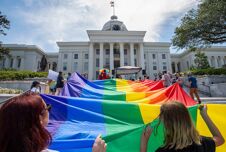In honor of Women’s History Month, we’re highlighting some of the many incredible LGBTQ+ women of both the past and present, women who overcame unimaginable obstacles to change the world.
In her glowing white tails, matching top hat, and shining shoes, Gladys Bentley didn’t just exude Steal Your Girl energy. She stood centerstage, swaggering and spotlit, and promised with a flourish of piano keys she’d be stealing everyone’s girl.
Related:
The Black queer icon who spied on Nazis, flew a WWII plane, & was also a vaudeville superstar
To fans, Josephine Baker was the ultimate sex symbol. But behind the scenes, she played a crucial role in the second World War.
For a brief, glittering moment in Prohibition history, Bentley’s was the best show in Harlem, an act so audaciously queer and Black the New York Police Department had to padlock club doors to keep her liberation vibes from spreading. But despite coordinated censorship efforts — and the artist’s own Lavender Scare-era reversal about her sexuality — Gladys Bentley’s legacy has lived on, building the foundation upon which modern stars like Janelle Monae and Lil Nas X twerk today.
Never Miss a Beat
Subscribe to our newsletter to stay ahead of the latest LGBTQ+ political news and insights.
Born in 1907 in Philadelphia, Pennsylvania, Gladys Bentley was clear on who she was from an early age. The eldest child of a Trinidadian mother and African American father, she began stealing her brothers’ suits to wear around age 9. Her infatuation with female school teachers and commitment to “unladylike” presentation caused the low-income family to seek help from doctors, who unsurprisingly could not “fix” their gender-nonconforming patient. Her family’s disapproval and chronic rejection ultimately drove Bentley to use music as an escape before fleeing the house entirely.
At age 16, young Bentley left Philly for New York City in search of belonging and a Broadway agent. Her booming alto voice and songwriting skills were substantial enough to land one, and Bentley even cut a recording deal paying $400 whole dollars for 8 “sides.” But opportunities for Black female artists like Bentley— short-haired, thick-hipped, gorgeously butch — were even more limited than they were for other Black artists, though all were hamstrung by segregation.
Bentley cobbled together income by singing at “rent parties,” one of the few legitimate safe spaces for lesbians in Harlem. These raucous gatherings, protected by private invitations and passwords, offered financial support to the assigned beneficiary that week and flirty fun for LGBTQ+ community members unwelcome in white or heterosexual bars. As the featured entertainment, accompanying herself on piano and singing without amplification, Bentley scandalized attendees with graphically sexual parodies of popular hits.
“She quickly made a name for herself as somebody who sang ribald songs,” historian Jim Wilson, author of Bulldaggers, Pansies, and Chocolate Babies: Performance, Race, and Sexuality in the Harlem Renaissance, writes. “She took the songs ‘Sweet Alice Blue Gown’ and ‘Georgia Brown,’ and it became a song about anal sex.”
Her underground success as a queer shindig star encouraged Bentley to audition when local clubs, specifically the Mad House on Harlem’s 133rd Street, were looking for acts – though she was usually competing against men for gigs. “At the Mad House, the boss was reluctant to give me a chance,” she wrote. “I finally convinced him. My hands fairly flew over the keys. When I had finished my first number, the bust of applause was terrific.”
She became the venue’s biggest draw in a matter of months.
Before long, Bentley was headlining at the Ubangi Club, Clam House, and Cotton Club. This was during the height of Prohibition, when well-monied white tourists were willing to step over racial lines if mingling with Harlem’s Blacks and queers could provide access to speakeasy gin. Bentley’s cross-dressing, scandalous lyrics, playful roasts of male attendees, and open flirting with women were unlike anything most audiences had encountered, elevating the show from standard nightclub fare to a rarified saturnalia.
Langston Hughes himself wrote about seeing her perform: “For two or three amazing years, Miss Bentley sat, and played piano all night long… with scarcely a break between the notes, sliding from one song to another, with a powerful and continuous underbeat of jungle rhythm. Miss Bentley was an amazing exhibition of musical energy—a large, dark, masculine lady, whose feet pounded the floor while her fingers pounded the keyboard, a perfect piece of African sculpture, animated by her own rhythm.”
Alongside bandleaders like Duke Ellington and New Orleans-based trumpeter Louis Armstrong, singers like Billie Holiday and Bessie Smith, and composers like James P. Johnson, Bentley helped shape the sound and aesthetics of the Harlem Renaissance, a movement that cemented jazz and the Blues as uniquely Black and American art forms. The work also delivered Bentley out of poverty, putting her in a Park Avenue apartment with a parade of support staff and pretty girlfriends.
But being a “bulldagger” — a vintage slur for a masculine gay woman — in 20th-century showbiz was not easy. Femme bisexual and lesbian women could still be ogled behind the scenes and sold as sex objects onstage. Butch dykes, by comparison, threw a wrench in the industry’s misogynistic hierarchy.
Existing became even harder as The Jazz Age transitioned first into WWII, then into “The Post War United States” – that decades-long backslide into conservative “values” and patriotic posturing. The repeal of Prohibition decimated Harlem’s speakeasy scene, driving Bentley onto the touring circuit before depositing her in Southern California. She rebranded as “America’s Greatest Sepia Piano Player,” but encountered ongoing backlash about her gender expression, even having to obtain special permits to dress in her signature suits.
Bentley continued to endure bigoted harassment as part of the McCarthy Era’s aggressively anti-communist — and, by extension, anti-queer — pendulum swing. The Lavender Scare threatened to not just obliterate financial security for anyone accused but also saw homosexuals thrown in prison and transgender individuals violently brutalized in ways still familiar today.
Bentley started appearing publicly in dresses and matronly braids. In 1952, the 45-year-old singer announced she’d not only married a 20-something line cook named Charles Roberts, a man she’d known for five months but also claimed she’d “cured” her homosexuality via hormone therapy.
This is, as anyone who’s ever taken estrogen or testosterone can attest, not how hormones work. But given homosexuality was still framed as a treatable mental illness at the time — the American Psychological Association wouldn’t reverse course on it until the mid-1960s — queer folks faced widespread pressure to pursue treatment and “convert.” The social coercion was especially potent in the Black community, where misogyny mandated women become “good wives” to secure stability.
“For many years I lived in a personal hell,” Bentley penned in an evangelical essay, titled I Am A Woman Again, for Ebony magazine. “Like a great number of lost souls, I inhabited that half-shadow no-man’s-land which exists between the boundaries of the two sexes… society shuns us. The unscrupulous exploit us. Very few people understand us.”
The piece, featuring portraits of Bentley fixing dinner in a housedress, details how “the magic of modern medicine” and faith allowed her to find a man to marry. It also blamed her homosexuality on Bentley’s mother rejecting her for not being a son. “I learned that ‘different’ people are made, not born.”
Whether the article was an earnest confessional or a calculated manipulation of the media is unclear. Bentley was known for staging weddings as PR, including one in Atlantic City to a white woman and another to a man named J.T. Gibson, who later denied the event ever happened.
How the rest of Bentley’s story would play out was interrupted quite suddenly in 1960, when she contracted a serious case of influenza. Bentley ultimately succumbed to secondary pneumonia at just 52 years old.
Had she been given more time, it’s not impossible Bentley would have reinvented herself yet again once the Communist scare was finally buried. Regardless, her impact as a trailblazing performer and gender nonconformist lingers a full century after her dazzling first impression in Harlem.

















